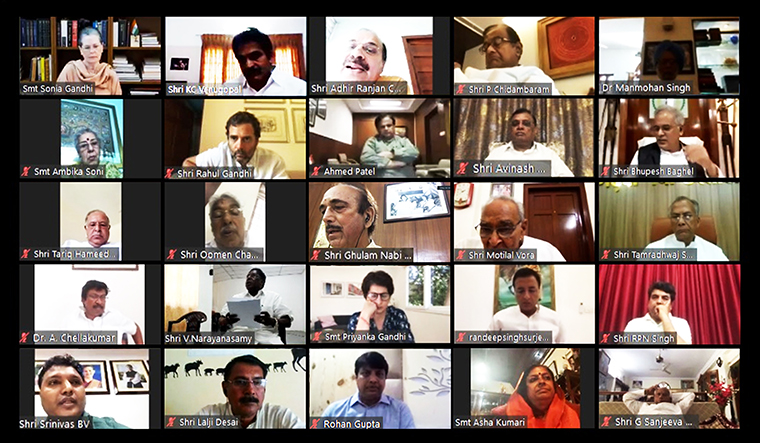A day before the Congress Working Committee met on April 2 to discuss the fallout of the Covid-19 pandemic, members learnt the ropes of an online interaction that involved a large number of participants. The CWC members participated in a mock e-meeting, where they were familiarised with concepts such as adjusting the webcam and ‘muting’ and ‘unmuting’ themselves. They were also briefed about the protocol involved in a web-based interaction. The next day, the highest decision-making body of the Congress held its first-ever videoconference meeting. For the grand old party, it was nothing short of a leap of faith, and the leaders took to it rather well.
Desperate times breed desperate measures, but sometimes they can inspire innovative solutions, and the social distancing norms to contain the spread of Covid-19 have resulted in parties and leaders taking politics to the virtual space.
“It is not very challenging for us now,” said K.C. Venugopal, AICC general secretary in charge of organisation. “Our social media team is fully equipped for this task. We are doing videoconferencing both at the national and state levels. We are using social media platforms to connect with Congress workers and the people. I think it is effective.”
Zoom, Skype and webcasting have become part of political jargon. If the Congress leaders went online with Zoom, the BJP, which has been a frontrunner in using technology, has also taken to virtual media to bridge the physical gap.
BJP president J.P. Nadda is holding several meetings daily on Skype. At 7pm, Nadda logs in for discussions with office bearers, party MPs, state leaders and spokespersons. This is among the eight to ten daily videoconferences organised by the party, the logistics of which is arranged by the party’s social media department.
Coordinating party work is currently focused on lockdown-related relief activities, down to the grassroots. The state in-charges, MPs and local unit chiefs are using video and audio conferences to coordinate activities such as providing rations and meals to the poor, helping migrant workers and encouraging donations to PM-CARES fund.
The BJP office bearers and MPs have been assigned different regions to coordinate relief work. “Once we started having videoconferences on Skype with our national president, it had a trickle-down effect,” said Rajiv Pratap Rudy, BJP MP from Saran. “The party asked us to do it at our level also, so I have become an expert at it. I have videoconferences with my party workers and the officials in my constituency on a daily basis.”
Rudy said his team in his constituency is enthusiastic about the online meetings despite the occasional drop in signal strength. “They keep their family members around, and their neighbours drop in to see what is happening,” he said.
BJP’s IT cell head Amit Malviya said the party is “platform agnostic”. “We use all [platforms] depending on convenience and utility,” he said. “We have to adapt to innovative ways in times like these.”
The Congress discovered the virtues of videoconferencing when, on March 28, there was an online meeting of 82 leaders, including general secretaries, state unit chiefs, heads of frontal organisations and leaders of the Congress legislature parties in the states. This was the party’s first-ever virtual meeting on such a large scale. At this meeting, the party decided to set up control rooms down to the district level, to collect daily reportage on the actual ground situation of Covid-19, the medical preparedness of the states, and also the relief activities being undertaken by the party and state agencies. Prior to the online CWC meeting, Congress president Sonia Gandhi had a meeting on similar lines with the chief ministers of the party-ruled states.
The follow-up of the CWC meeting is also being done online, according to Rohan Gupta, who heads the Congress’ social media team. “State office bearers are meeting on videoconferences to discuss the needs of the people and what demands they should raise with the government,” he said. Leaders are realising the convenience of videoconferencing and the advantages in terms of conserving resources. One only needs to alert everybody with a WhatsApp, and anybody can join the meeting, without moving geographically.
The Congress then decided to hold its media briefings online, too, albeit it did encounter the minor issue of reminding participating work-from-home journalists to be presentable as they would also be visible in the video. “We realised that we could do our press conferences also using Zoom, unaware of how successful it would be. We had no other option. And it worked,” said Pranav Jha, AICC secretary in charge of communication.
The Aam Aadmi Party’s internal meetings have also shifted to Zoom to ensure party leaders have a coordinated approach on issues. Chief Minister Arvind Kejriwal held a videoconference with all the party MLAs, after which a number of them sought the help of the party’s social media team to set up their meetings with local officials, resident welfare associations and their constituents.
Kejriwal has daily video meetings with Lt Governor Anil Baijal, senior officers in the national capital and party leaders. Even before the national lockdown was announced, Kejriwal had shifted to virtual media briefings to enforce social distancing.
AAP’s Akshay Marathe said the experiences gained during the lockdown could result in parties adopting online means to communicate to a greater extent in future. “Social distancing will alter behaviour in many ways, and there is no doubt politicians and activists will adopt videoconferencing even in the longer term.”


